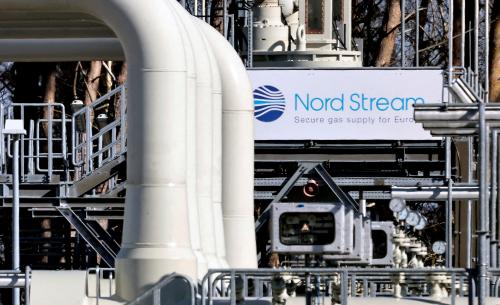Editor’s Note: In testimony before the U.S.-China Economic and Security Review Commission, Erica Downs discusses China’s energy trade with and investment in the Middle East, and the implications of the resurgence of oil and natural gas production in the United States for China’s role in the Middle East.
View a webcast of the hearing on the USCC website »
I would like to thank the members of the Commission for the opportunity to testify. It is an honor to participate in this hearing.
My remarks today will focus on China’s energy relations with the Middle East. I will discuss China’s energy trade with and investment in the region and the implications of the resurgence of oil and natural gas production in the United States for China’s role in the Middle East.
China’s oil trade with the Middle East
China imports more oil from the Middle East than any other region of the world. In 2011, China imported 2.9 million barrels per day (b/d) of Middle Eastern oil, which accounted for 60 percent of China’s oil imports. For comparison, the United States imported 2.5 million barrels per day of oil from the Middle East in 2011, accounting for 26 percent of US oil imports.[1]
China’s largest crude oil supplier is Saudi Arabia, which provided China with one-fifth of its crude oil imports — almost 1.1 million b/d – last year.[2] Saudi Arabia has been China’s top crude oil supplier for the past decade. The Kingdom has established itself as a very reliable supplier in both word and deed. Saudi officials have repeatedly reassured the Chinese that they can count on Saudi Arabia to provide China with the oil it needs for continued economic growth.[3] Saudi Aramco has backed up this commitment with its participation in a joint venture refinery in China’s Fujian Province, which processes Saudi crude.
China’s oil imports from Iran– its fourth largest supplier in 2012 and third largest supplier for most of the previous decade– have recently declined, probably as a result of US sanctions aimed at reducing Iran’s revenue from crude oil exports. The National Defense Authorization Act of 2012 prescribes penalties for foreign financial institutions which do business with the Central Bank of Iran, the main clearinghouse for oil payments, but also grants 180-day exemptions to countries that “significantly reduce” oil imports from Iran. China’s imports of Iranian crude have fallen from 555,000 b/d in 2011 to 439,000 b/d in 2012 to 402,000 b/d during the period January-April 2013. These reductions earned China exemptions in June and December 2012 and June 2013.[4]
China’s oil investments in the Middle East
The Chinese national oil companies’ largest upstream projects in the Middle East are in Iraq and Iran. The firms have signed service contracts to develop several large oil fields in both countries. (These include al-Ahdab, Halfaya and Rumaila in Iraq and Azadegan and Yadavaran in Iran.) The projects in Iraq have progressed much more quickly than the projects in Iran.
China National Petroleum Corporation (CNPC), which moved quickly to develop a foothold in the postwar Iraqi oil industry, is one of the largest foreign companies, in terms of production, operating in Iraq. One of the crown jewels of CNPC’s international upstream portfolio is Iraq’s Rumaila oil field, which CNPC is developing in partnership with BP. Last year, Rumaila accounted for more than one third of Iraq’s oil output. It was also CNPC’s top-producing overseas project, accounting for almost half of CNPC’s net overseas oil and natural gas production.[5]
In contrast, the upstream activities of CNPC and its domestic peers in Iran have slowed in recent years. The Iranians suspended the contract of China National Offshore Oil Corporation (CNOOC) for the development of the North Pars natural gas field in 2011 for lack of progress, and CNPC withdrew from developing phase 11 of South Pars, the world’s largest natural gas field in 2012 (after the Iranians threatened to void CNPC’s contract for lack of progress).[6] CNPC is behind schedule in developing the Azadegan oil field, and Sinopec ‘s work on the Yadavaran oil field reportedly has suffered delays. [7] The reasons for the shrinking presence of China’s oil companies in Iran include sanctions that have made it difficult for China’s oil companies to secure equipment and technologies needed to operate in Iran, unhappiness with contract terms, uncertainty about whether Iran’s nuclear program will spark a military conflict, and reported guidance from China’s leadership to move slowly in Iran.[8]
In sum, the Chinese oil companies’ strategy for securing upstream projects in Iran has been one of “talk now and spend later.” In the 2000s, the companies were happy to negotiate contracts for projects that would almost certainly have been awarded to major international oil companies in the absence of sanctions. However, they have not been in any rush to actually pump large sums of money into Iran.
The Implications of greater American energy self-sufficiency for China’s role in the Middle East
I would also like to say a few words about how the resurgence of oil and natural gas production in the United States may reshape the roles of the United States and China in the Middle East. The International Energy Agency projects that the United States’ oil imports from the Middle East will fall from 1.9 million b/d in 2011 to just 100,000 b/d –3 percent of total oil imports– in 2035 as a result of increasing domestic oil production and decreasing demand. In contrast, China’s oil imports from the Middle East are projected to grow from 2.9 million b/d in 2011 to 6.7 million b/d — 54 percent of total oil imports– in 2035.[9]
These trends have prompted speculation about future US military posture in the Persian Gulf and, in turn, what it might mean for the security of regional oil flows to China. It is highly unlikely that the United States would completely disengage from the Middle East; Washington will almost certainly retain a variety of interests in the region, including the free flow of oil, counterterrorism and nuclear nonproliferation, even if the United States is importing little or no oil from the Middle East. However, if a diminishing appetite for Middle Eastern crudes and budgetary constraints were to prompt Washington to substantially reduce its military presence in the region, oil security concerns might compel Beijing to play a larger role in defusing the primary threat to the free flow of oil from the Persian Gulf – the closure of the Strait of Hormuz by Iran. At a minimum, this might entail Beijing communicating to Tehran that it would regard the disruption of oil exports bound for China as a threat to one of China’s vital interests, similar to the public warning then-Premier Wen Jiabao issued in Qatar in January 2012.[10] A less likely but more active Chinese effort might involve reinforcing verbal admonitions with the stationing of a ship in the Persian Gulf, perhaps from one the multinational regional antipiracy patrols in which the Chinese navy participates.[11]
Finally, it is worth noting that the boom in oil and natural gas production in North America may provide Washington with more leverage over the activities of China’s national oil companies in Iran. North America is now the epicenter of global mergers and acquisitions in oil and natural gas exploration and production. In 2011, for example, 60% of all upstream mergers and acquisitions worldwide were in North America.[12] China’s national oil companies are part of this story. Since 2009, almost half of the capital Chinese oil companies have spent on overseas mergers and acquisitions has been used to purchase assets in North America. In the United States alone, Chinese oil companies have invested more than $8 billion since 2010. Chinese oil executives have indicated continued interest in acquiring additional assets in North America.[13]
The more Chinese oil companies are invested in the United States, the more likely they are to think twice about doing business in Iran. This is because involvement in the Iranian oil industry may undermine the efforts of Chinese oil companies to expand their presence in the United States in two ways. First, any proposed acquisition that would result in foreign control of an American business — such as CNOOC’s recent acquisition of Nexen – should be reviewed by the Committee on Foreign Investment in the United States (CFIUS) for national security risks, and it is likely that CFIUS would inquire about the nature of the acquirer’s activities in Iran. Second, Chinese oil companies are acutely aware of how public opinion can scuttle a deal thanks to CNOOC’s unsuccessful bid for Unocal in 2005. Strong opposition to a Chinese oil company’s business in Iran might prevent that company from acquiring an asset in the United States by making the transaction costs unacceptably high. In sum, opportunities to invest in the United States might diminish the appetite of China’s national oil companies for undertaking projects in Iran.
Thank you. I look forward to your questions.
[1] International Energy Agency, World Energy Outlook 2012 (Paris: OECD/IEA, 2012), pp. 85, 107; and data provided by the International Energy Agency by email on May 29, 2013.
[2] “Table of China December Data on Oil, Oil Product and LNG Imports,” Dow Jones Global Equities News, January 21, 2013.
[3] See, for example, Ali Ibrahim Al-Naimi, Speech at the Conferment Ceremony of Honorary Doctorate, Peking University, Beijing, China, November 13, 2009, http://www.kaust.edu.sa/about/bot/speeches/PekingUniversitySpeech.html.
[4] Nidhi Verma and Meeyoung Cho, “India leads Asian cuts in Iran oil imports ahead of waiver review,” Reuters, May 21, 2013, http://www.reuters.com/article/2013/05/22/iran-sanctions-waiver-idUSL3N0E30D720130522; “Market Eye: China Demand Growth Sputters to Seven-month Low,” International Oil Daily, April 23, 2013; Judy Hua and Chen Aizhu, “Update 2 – China’s Feb crude imports from Iran up 81 pct on yr,” Reuters, March 21, 2013, http://www.reuters.com/article/2013/03/21/china-oil-iran-idUSL3N0CC0CS20130321; “Table of China December Data on Oil, Oil Product and LNG Imports,” Dow Jones Global Equities News, January 21, 2013; and “Oil Data: Table of China December Oil, Oil Pdt, LNG Imports,” Dow Jones International News, January 20, 2012.
[5] He Qing “Zai mou zhaobiao: Zhongshiyou de Yilake jingji zhang” (“Planning another bid: CNPC’s Iraqi balance sheet”), 21st shjiji jingji daobao (21st Century Business Herald), April 20, 2013, http://finance.qq.com/a/20130420/000560.htm; “Unrest Hits CNPC’s 2012 Output,” International Oil Daily, January 18, 2013; and Aref Mohammed and Ahmed Rasheed, “Update 2 – BP proposed cuts to Iraq’s Rumaila target,” Reuters, December 13, 2012, http://www.reuters.com/article/2012/12/13/energy-iraq-rumaila-idUSL5E8ND7YS20121213.
[6] “Iran Set to Replace CNPC with Local Firms at South Pars 11,” International Oil Daily, April 23, 2013; and “CNPC to Withdraw from Iran’s South Pars Project,” International Oil Daily, September 28, 2012; “CNOOC Iran Gas Project Suspended,” SinoCast, October 14, 2011; and “Iran suspends $16 billion Chinese gas deal,” Platts Oilgram News, October 12, 2011.
[7] “CNPC, NIOC Eye Early Production at South Azadegan,” International Oil Daily, April 1, 2013; “Sanctions Show Importance of China for Iran’s Economy,” June 24, 2012; and “Output of Iran’s Yadavaran field reaches 16,000 b/d,” Platts Oilgram News, May 2, 2012.
[8] For more on the government’s guidance, see Chen Aizhu, “Exclusive: China slows Iran oil work as U.S. energy ties warm,” Reuters, October 28, 2010, http://www.reuters.com/article/2010/10/28/us-china-iran-oil-idUSTRE69R1L120101028.
[9] International Energy Agency, World Energy Outlook 2012 (Paris: OECD/IEA, 2012), pp. 78-80; and data provided by the International Energy Agency by email on May 29, 2013.
[10] “Records of Premier Wen Jiabao’s Press Conference at Doha Just Before the End of His Official Visits to the Three Gulf States,” January 18, 2012, http://www.fmprc.gov.cn/ce/cebel/eng/zxxx/t898607.htm.
[11] This paragraph is based in part on an email exchange between the author and Rear Admiral Michael McDevitt, US Navy (ret.) on May 28-30, 2013.
[12] “2011 Bumper Year for European Upstream M&A,” EI Finance, January 25, 2012.
[13] Rakteem Katakey, Aibing Guo and Sarah Chen, “China Joining US Shale Renaissance With $40 billion,” Bloomberg News, March 6, 2013, http://mobile.bloomberg.com/news/2013-03-05/china-joining-u-s-shale-renaissance-with-40-billion.html; and Judy Hua and Fayen Wong, “China’s Sinopec says still seeking assets in N. America,” Reuters, March 4, 2013, http://www.reuters.com/article/2013/03/05/china-npc-sinopec-idUSB9E8LA02G20130305.



Commentary
TestimonyChina-Middle East Energy Relations
June 6, 2013